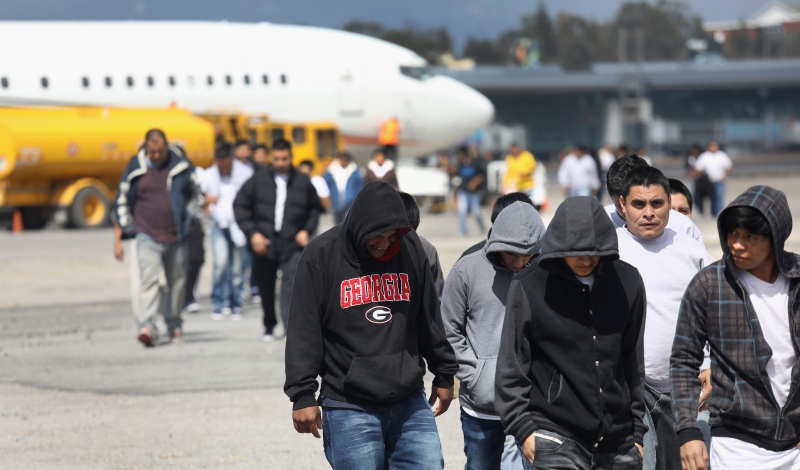
Scholars document the abuse of noncitizens in airports and airplanes across previous administrations.
Each year, U.S. Immigration and Customs Enforcement (ICE) deports more than 200,000 individuals to nearly 200 countries. Forcibly expelling that many people to that many places is no simple undertaking. To carry out this monumental task, ICE has created a complex system consisting of airports and airplanes—and, apparently, rampant human rights abuses.
In a paper released last fall, three legal experts shine a light on what they characterize as ICE’s history of human rights violations at the airports and airplanes used for deportation.
Immigration advocates have long criticized ICE’s treatment of noncitizens. Much of this criticism has focused on civil and human rights violations within ICE detention facilities. But ICE’s airline network—aptly called ICE Air—operates largely outside of public scrutiny and also can be a venue for abuse.
From 2010 to 2018, ICE Air transported nearly 1.73 million people on more than 15,000 flights. ICE Air has managed to fly under the radar primarily because of its sheer complexity and its increasing privatization.
In 2010, ICE began outsourcing the complicated task of conducting deportation flights to private charter operators. Most recently, ICE subcontracts to a single broker, which subcontracts with other charter companies, which in turn often hire their own subcontractors. The subcontractors must then contract with other businesses that coordinate logistics and pay airport fees. This layered multi-subcontractor structure has obscured transparency and hinders attempts to learn about ICE Air’s inner workings.
In their paper, however, law professor Deborah M. Weissman, lawyer Havan M. Clark, and human rights professor Angelina Snodgrass Godoy charge that many human rights abuses that ICE Air both facilitates and creates occur behind the veil of this privatized “web of operations.”
ICE Air officials often “aid and abet” rights violations by executing unlawful deportations, Weissman, Clark, and Godoy allege. This occurs, for instance, when ICE deports noncitizens while their legal proceedings are still pending, violating constitutional due process rights. In one case, ICE deported a mother and daughter on the very morning that they were supposed to appear in court for a hearing to suspend temporarily their removal, according to Weissman, Clark, and Godoy. Outraged, the judge overseeing their case ordered ICE to “turn that plane around … and bring those people back to the United States.”
That mother and daughter’s case is not an isolated incident. Between 2011 and 2018, ICE’s own records reveal that ICE Air deported over 8,000 noncitizens with pending proceedings at the time of deportation. In addition, ICE routinely removes noncitizens who have obtained immigration relief, noncitizens whose deportation orders are legally erroneous, and even U.S. citizens whom ICE mistakes for noncitizens. Once deported, these individuals have virtually no means of successfully seeking recourse. Weissman, Clark, and Godoy explain that, when ICE Air transports wrongful deportees, it perpetuates “the underlying rights violations.”
They also report human rights abuses that ICE Air commits in the airports and airplanes that make up the agency’s network. In one infamous incident involving 92 Somali noncitizens, ICE agents “punched and kicked people, choked them, stepped on their shackles, and threw them on the floor, drawing blood and causing injury.” In another, ICE agents forced 15 deportees into “body bags” and bound them “tightly with numerous Velcro belts” before dragging them onto the plane.
These are some of the incidents that have come to light. Weissman, Clark, and Godoy surmise that many other accounts never surface in large part because most deportation flights cause deportees basically to disappear from the perspective of U.S. human rights activists monitoring these cases.
But human rights organizations, through persistent investigation, have uncovered more accounts of ICE Air abuses. A document obtained through a Freedom of Information Act request, for example, revealed 99 complaints whose summaries included the word “flight.”“ In one complaint, a Salvadoran woman miscarried triplets on an ICE Air plane after experiencing violence in the airport. Another complaint revealed that a Honduran woman died during her deportation flight. Others showed ICE officers humiliating deportees, calling them “scum” and accusing them of “taking our jobs.”
According to Weissman, Clark, and Godoy, this treatment violates several fundamental human rights such as human dignity, freedom from torture, and “the right to due process of law.” Various treaties, agreements, and international norms require the United States to respect these rights. And to ensure that it does, advocates have crafted creative strategies to push back against ICE Air. They are, for example, pressing local government to stop cooperating with ICE Air, thereby limiting deportation flights from local airports.
Events that unfolded in King County, Washington illustrate this strategy. University researchers had documented the human rights violations ICE Air perpetrated and published their findings to expose how ICE and its contractors “upended the lives of many deportees” at the King County airport. Advocates then used those findings as part of a successful political campaign targeting local officials, who issued an executive order prohibiting deportation flights from using the municipal airport, located near an ICE detention facility used to hold deportees. As a result, ICE must now reroute deportation flights out of a different airport, about 150 miles away, creating “significant operational difficulties and additional costs for ICE.”
Weissman, Clark, and Godoy hold up the success of advocates in Washington state as one way that the public can hold ICE, and specifically ICE Air, accountable for human rights violations. They argue that, unless and until ICE reforms its practices, local activism may be the most immediate and effective way to thwart ICE Air’s abuses.



